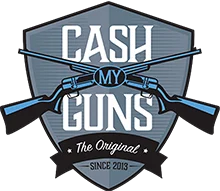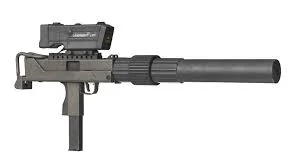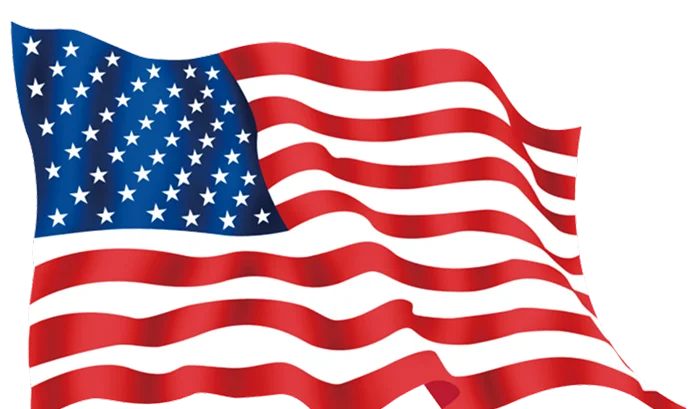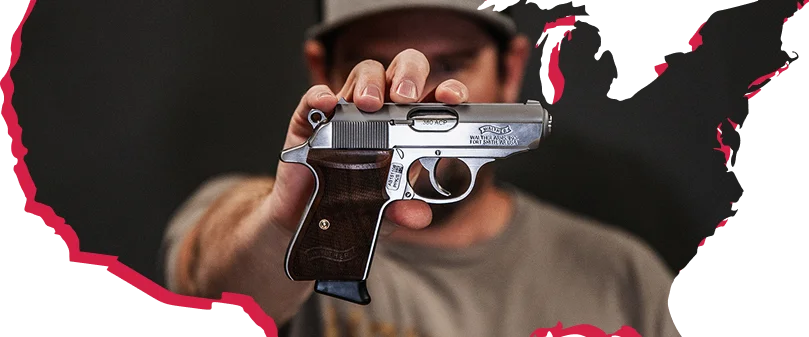Current market values, pricing factors, and what collectors actually pay for transferable MAC-10 submachine guns
Your transferable MAC-10 is worth between $8,000 and $14,000 in today’s market. That’s a wide range, and where your specific gun falls depends on several concrete factors.
The MAC-10 submachine gun earned its reputation through simplicity. Gordon Ingram designed it for the Military Armament Corporation with stamped steel construction that kept costs down while maintaining reliability. The boxy profile and vertical magazine housing make it instantly recognizable, even to people who’ve never handled one.
The Gordon Ingram Story and Design Philosophy
Gordon Ingram wasn’t new to submachine gun design when he created the MAC-10. He’d already built the M6 in the late 1940s and continued refining his ideas through the 1950s and 60s. His goal stayed consistent: create submachine guns that manufacturers could produce cheaply while maintaining battlefield reliability.
Ingram founded the Military Armament Corporation in 1970 in Powder Springs, Georgia. The company name reflected his ambition to supply military and law enforcement markets worldwide. He brought decades of firearms engineering experience to the project, and his design philosophy centered on three principles:
Stamped steel construction that eliminated expensive machining operations. The MAC-10’s receiver is formed from sheet steel, bent and welded into shape. This dropped manufacturing costs dramatically compared to milled receivers.
Simple blowback operation with minimal moving parts. The bolt cycles through brute force rather than complex locking mechanisms. Fewer parts meant easier maintenance and higher reliability in harsh conditions.
Compact dimensions achieved through telescoping bolt design. The bolt wraps around the barrel, allowing the overall length to stay under 11 inches with stock collapsed. This “overhung” bolt design became the MAC-10’s most distinctive engineering feature.
The result looked crude because it was crude. Ingram made no apologies for the boxy appearance or the rudimentary sights. He designed a weapon system, and the real innovation came with the integrated suppressor designed by Mitchell WerBell III.
Mitchell WerBell III and the Sionics Suppressor
No discussion of the MAC-10’s history is complete without Mitchell WerBell III. A former OSS officer with a flair for self-promotion, WerBell ran Sionics (Studies In the Operational Negation of Insurgents and Counter-Subversion) and developed some of the most effective suppressors of the era.
WerBell’s suppressor transformed the MAC-10 from a barely controllable bullet hose into something approaching a useful weapon. The suppressor added 12 inches of length and significant weight forward of the grip, which helped manage the extreme rate of fire. It also reduced the sound signature dramatically, though “silenced” remained Hollywood fiction.
The Ingram-WerBell partnership created the iconic image most people associate with the MAC-10: the fat suppressor extending well beyond the stubby receiver. Military Armament Corporation marketed them as a package, and the suppressor became standard equipment for serious users.
Hollywood discovered the MAC-10 in the late 1970s and early 80s. The weapon appeared in everything from action films to Miami Vice. This pop culture visibility created demand among civilian collectors but also contributed to negative perceptions that would later impact the company’s viability.
Technical Specifications and Operating Characteristics
Gordon B. Ingram
United States
Military Armament Corporation (1970-1976), RPB Industries (1972-1983), SWD Inc./Cobray (1983-1986)
1970-1986 (transferable models)
.45 ACP or 9x19mm Parabellum
Straight blowback, open bolt, selective fire
1,090 rpm (.45 ACP) / 1,145 rpm (9mm)
30 rounds (.45 ACP), 32 rounds (9mm)
6.26 lbs (2.84 kg)
10.5 inches (stock collapsed) / 21.5 inches (stock extended)
5.75 inches
50-75 yards (practical)
That 1,090 rpm cyclic rate means the MAC-10 empties a 30-round magazine in roughly 1.6 seconds. Control became the defining challenge. Experienced shooters learned to fire in short bursts, but the weapon’s light weight and minimal stock made sustained accuracy difficult.
The open-bolt design contributed to the MAC-10’s reliability. Dirt and debris that would jam a closed-bolt gun simply fell through the action. Combat veterans appreciated this characteristic, though it made the weapon less suitable for precision applications.
Manufacturing History and Company Evolution
Military Armament Corporation (1970-1976)
Military Armament Corporation began production in Powder Springs, Georgia in 1970. Ingram held high hopes for military contracts, and initial interest seemed promising. The U.S. military tested the MAC-10, but standardization around the M16 platform meant no large-scale adoption materialized.
The company targeted foreign military sales and law enforcement agencies. Some success came with police SWAT teams in the early 1970s, but budget constraints and concerns about the weapon’s controllability limited widespread adoption.
RPB Industries (1972-1983)
RPB Industries of Atlanta began manufacturing MAC-10 variants in 1972 while Military Armament Corporation still operated. RPB produced both full-auto versions and semi-automatic variants for the civilian market. Their receivers carry RPB markings, and these examples appear regularly in the transferable market today.
RPB continued after MAC folded, becoming the primary source for MAC-10s through the late 1970s and early 1980s. Quality varied during this period. Early RPB guns maintained standards close to original MAC production, but later examples sometimes showed inconsistent fit and finish.
SWD Inc. and Cobray (1983-1986)
SWD Inc. (Sylvia and Wayne Daniel) acquired the rights and tooling from RPB Industries in 1983. Operating under the Cobray name, they produced MAC-10s and MAC-11s until the Hughes Amendment closed the machine gun registry in May 1986.
SWD/Cobray focused heavily on semi-automatic versions for civilian sales, but they also registered significant numbers of transferable machine guns before the 1986 deadline. These late-production transferable MAC-10s from 1984-1986 make up a substantial portion of the current market.
The company continued producing semi-automatic variants after 1986, but these lack the transferable status that creates value in today’s collector market. Only MAC-10s registered before May 19, 1986 can transfer between private citizens.
Military and Law Enforcement Adoption
The MAC-10’s military service never reached Ingram’s ambitious goals, but the weapon found its niche in specialized applications. Understanding who actually used these guns helps explain their historical significance beyond pop culture appearances.
United States Military Use
U.S. military adoption remained extremely limited. Some Special Forces units tested MAC-10s during the Vietnam era, appreciating the compact size for tunnel operations and vehicle work. But the weapon never achieved official procurement status or formal designation.
The suppressed versions attracted more interest from covert operations units. The combination of subsonic .45 ACP ammunition and WerBell’s suppressor created a genuinely quiet weapon system useful for specific missions. These remained small-quantity acquisitions rather than standard issue.
Foreign Military Sales
International sales exceeded domestic military adoption. Several countries purchased MAC-10s for special forces and counter-terrorism units:
Cuban exile forces and anti-communist groups in Central America used MAC-10s during the 1970s and 80s. These weapons appeared in various conflicts throughout the region, often supplied through unofficial channels.
The Argentine military purchased MAC-10s before the Falklands War. British forces captured examples during the conflict, leading to extensive technical evaluation.
Israeli security forces tested the weapon but ultimately selected the Uzi for standardization. Some MAC-10s remained in use with specialized units through the 1980s.
Law Enforcement Agencies
American law enforcement showed the strongest interest in MAC-10 submachine guns during the 1970s. SWAT teams across the country acquired them, attracted by the compact dimensions and high firepower for close-quarters operations.
The Los Angeles Police Department tested MAC-10s extensively. Several other major city police departments followed suit. However, concerns about overpenetration in urban environments and the weapon’s limited effective range led many agencies to abandon MAC-10s in favor of more controllable options by the mid-1980s.
The Drug Enforcement Administration used suppressed MAC-10s for specific operations. The Secret Service acquired limited numbers for protective details, valuing the weapon’s ability to deliver substantial firepower from a concealable package.
Design Strengths and Weaknesses
What the MAC-10 Did Right
Reliability in adverse conditions stands as the MAC-10’s greatest strength. The simple blowback action and open-bolt design tolerated dirt, sand, and poor maintenance better than many contemporary weapons. Users consistently reported that MAC-10s kept running when other firearms stopped.
The compact size created genuine advantages for vehicle crews, aircraft personnel, and anyone working in confined spaces. At 10.5 inches with the stock collapsed, you could store a MAC-10 in spaces where an M16 or even an Uzi wouldn’t fit.
Manufacturing efficiency meant Military Armament Corporation could produce these weapons for roughly $200 in materials and labor during the early 1970s. This cost advantage made the MAC-10 accessible to agencies with limited budgets.
The Inherent Problems
Controllability plagued the MAC-10 throughout its service life. The extreme rate of fire, minimal weight, and rudimentary sights made accurate fire beyond point-blank range nearly impossible for untrained users. Even experienced shooters struggled to keep follow-up shots on target during full-auto strings.
The short barrel and high cyclic rate created excessive muzzle climb. Each round’s recoil impulse arrived before the shooter could recover from the previous shot. This turned the weapon into a bullet hose rather than a precision instrument.
Accuracy suffered from multiple factors. The crude fixed sights provided only basic aiming references. The short sight radius made precise alignment difficult. The heavy trigger pull and open-bolt design meant the weapon shifted during the firing process.
Magazine feed reliability created problems with aftermarket magazines. Original magazines worked well, but cheaper copies often caused feeding failures. The vertical magazine insertion from the grip meant that poorly made magazines could shift under recoil, causing jams.
The Hughes Amendment and Market Impact
May 19, 1986 changed everything for MAC-10 collectors. The Hughes Amendment to the Firearm Owners Protection Act closed the National Firearms Act registry to new machine guns. After that date, manufacturers could no longer register new transferable automatic weapons for civilian ownership.
This created a fixed supply of civilian-legal machine guns, including MAC-10s. Every MAC-10 currently in the transferable market was manufactured and registered by that May 1986 deadline. No new ones can enter civilian circulation.
The immediate impact wasn’t obvious. Throughout the late 1980s and early 1990s, transferable MAC-10s sold for $2,000-4,000. Demand remained modest, and many buyers viewed them as fun range toys rather than serious investments.
But as the years passed and no new supply entered the market, prices climbed steadily. By the 2000s, MAC-10 values had reached $6,000-8,000. The 2010s saw another jump as new collectors entered the NFA market and disposable income increased among firearms enthusiasts.
Today’s $8,000-14,000 price range reflects this scarcity. With perhaps 10,000-15,000 transferable MAC-10s in civilian hands (exact numbers remain unclear due to incomplete ATF records), these weapons represent a limited commodity in a growing market.
Current MAC-10 Market Values
Transferable MAC-10 machine guns command premium prices in the NFA collector market. The fixed supply created by the Hughes Amendment drives sustained demand, and the MAC-10’s iconic status in firearms history adds collector appeal beyond mere functionality.
Standard MAC-10 (.45 ACP or 9mm)
Typical Range: $8,000 – $12,000
Original Military Armament Corporation, RPB Industries, or SWD/Cobray receivers in working condition with standard configuration. Includes original magazines and basic accessories.
MAC-10 with LAGE Upper or Premium Accessories
Typical Range: $10,000 – $14,000
Enhanced configurations with LAGE Manufacturing uppers, original Sionics suppressors, quality optics, or documented military/law enforcement provenance.
Rare Variants and Special Markings
Typical Range: $12,000 – $16,000+
Early Military Armament Corporation production with special markings, documented military service history, or extremely low serial numbers. Premium examples with complete original accessories and paperwork.
Market conditions fluctuate seasonally. Prices tend to peak in fall and early winter as buyers prepare for holiday purchases and year-end spending. Spring typically sees softer prices as inventory accumulates from winter sales.
Online auction sites and specialized NFA dealers handle most transactions. Private sales between collectors happen frequently, but buyers need to verify transfer paperwork carefully before committing funds.
What Determines Your MAC-10’s Value
Manufacturer and Production Era
Early Military Armament Corporation MAC-10s from 1970-1972 command premium prices due to their historical significance and lower production numbers. These original production guns feature the distinctive MAC rollmarks and represent Gordon Ingram’s direct involvement with the company.
RPB Industries guns from the mid-1970s typically sell in the middle of the value range. Quality remained consistent during this period, and these weapons perform as reliably as original MAC production.
Late SWD/Cobray production from 1984-1986 makes up the bulk of available inventory. These guns work fine but lack the historical cachet of early MAC examples. They still command strong prices due to transferable status.
Original Configuration vs. Modifications
Original factory configuration with matching serial numbers on major components attracts serious collectors. A MAC-10 with original parts, factory markings, and period-correct accessories sells for more than modified examples.
That said, certain modifications add value rather than detract from it. LAGE Manufacturing uppers represent the most significant value-adding modification. These machined aluminum uppers replace the stamped steel originals and dramatically improve accuracy and controllability.
Original Sionics or SWD suppressors add substantial value if they’re registered to the weapon. Modern aftermarket suppressors matter less to collectors unless they’re high-quality examples from respected manufacturers.
Physical Condition and Functionality
A well-maintained MAC-10 in excellent mechanical condition commands top dollar. This means smooth bolt cycling, proper headspace, crisp trigger pull, and clean bore. Cosmetic wear matters less than mechanical soundness, though pristine examples bring premium prices.
Common wear patterns include finish loss on the bolt, magazine well scratches, and stock wobble. These issues are acceptable on working guns and don’t significantly impact value unless severe.
Major problems that hurt value include damaged receiver tubes, improper repairs, replaced barrels without proper threading, and missing or modified fire control parts. These issues can render a gun unsafe or difficult to shoot, dropping value significantly.
Documentation and Provenance
Can you prove your MAC-10 submachine gun served with a specific unit or appeared in a documented operation? That documentation transforms a functional firearm into a historical artifact. Military paperwork, unit photographs, or verified service records can add thousands to the base value.
Law enforcement agency markings attract collector interest. LAPD, DEA, Secret Service, or major city police department markings verify legitimate service use and create provenance that buyers value.
Original sales receipts, factory letters, or correspondence with Military Armament Corporation provide historical context that appeals to serious collectors. Even photocopies have value if the originals are lost.
Transfer Status and Registration
This matters most of all. Transferable status is what creates the $8,000+ valuation. Your civilian-transferable MAC-10 can change hands legally between private citizens through proper ATF Form 4 procedures. This transferability is what separates valuable collector items from dealer samples.
Dealer samples and post-1986 MAC-10s have minimal collector value because they can’t transfer to private citizens. Only federally licensed dealers with Special Occupational Tax stamps can possess these weapons, severely limiting the market.
Form 4 paperwork must show a registration date before May 19, 1986. No exceptions exist. If the registration date falls after the cutoff, the weapon isn’t transferable regardless of manufacture date.
Receiver Type and Manufacturing Origin
Original factory receivers are worth more than rewelds. A reweld happens when a registered receiver gets damaged and the serial plate gets transferred to a new tube. The process is legal and properly documented, but collectors prefer guns that haven’t required this level of repair.
Tube condition matters because the MAC-10 receiver is just stamped steel. Corrosion, deep scratches, or structural damage can compromise integrity. A clean, straight receiver tube with intact spot welds indicates proper care.
Accessories and Included Equipment
Original magazines add value, especially in quantity. MAC-10s shipped with at least two magazines, and having a complete set of originals appeals to collectors. Aftermarket magazines work fine but don’t command premium pricing.
The original sling, cleaning kit, and manual increase value modestly. Factory boxes or cases are rare enough that they substantially boost collectibility when present.
Period-correct accessories like early Sionics suppressors, original tactical lights, or vintage optics mounts can add significant value. Document everything with photos and provenance information.
The MAC-10 Legacy
The MAC-10’s influence on firearms design proved more subtle than Ingram hoped. The weapon never achieved the widespread military adoption he envisioned, but the compact submachine gun concept continues in modern designs.
You can see MAC-10 DNA in contemporary weapons like the B&T APC9, the SIG MPX, and various other compact submachine guns. The telescoping bolt design that wraps around the barrel became standard for achieving compact dimensions in automatic weapons.
The suppressor integration concept that WerBell pioneered with the MAC-10 influenced later weapon system development. Modern special operations weapons routinely ship with suppressors as integral components rather than awkward afterthoughts.
Pop culture immortalized the MAC-10 in ways Ingram never anticipated. The weapon became visual shorthand for everything from 1980s action films to modern video games. This recognition creates collector interest that extends beyond traditional firearms enthusiasts.
For better or worse, the MAC-10 shaped public perception of automatic weapons in America. Its prominent role in news coverage during the 1980s influenced the political debate that led to the Hughes Amendment. The very law that closed the registry also created the current collector market for transferable examples.
Get a Professional MAC-10 Valuation
Ready to sell your MAC-10 or get an accurate current market assessment? We’ll provide a professional evaluation based on your specific gun’s manufacturer, condition, and accessories, with expert support through the entire NFA transfer process.









